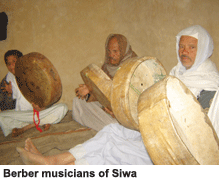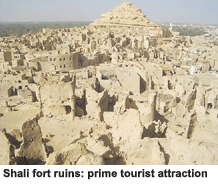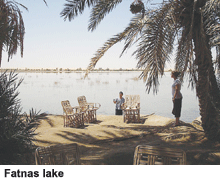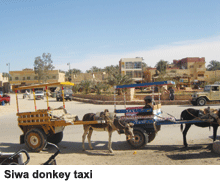Although they suffer legal and social discrimination from Egyptians and Arabs for sticking with their traditions and separate identity, the Berbers of the deep Dahara desert are warm, kind, and honest people, reports Yoginder Sikand
 After a hectic week of visiting half a dozen oases scattered in Egypt’s far-flung Western Sahara, I needed a break. And so, I travelled up to the ancient city of Alexandria (pop. 4 million), Egypt’s largest after Cairo.
After a hectic week of visiting half a dozen oases scattered in Egypt’s far-flung Western Sahara, I needed a break. And so, I travelled up to the ancient city of Alexandria (pop. 4 million), Egypt’s largest after Cairo.
Founded in 331 BC by Alexander the Great, Alexandria served as Egypt’s administrative capital for nearly a thousand years, until the Arab conquest in the seventh century CE (Common Era). I had planned to spend a quiet week, but the moment the bus pulled into Alexandria, I knew I had to leave in quick time. After several days in the still and empty environments of the desert, the din and human onslaughts of the city seemed too much to bear.
I quickly checked out the major tourist sites in Alexandria — a couple of ancient tombs and the legendary library dating back to Greek times — in less than half a day, desperate to get away from this city, which for some reason I couldn’t readily identify with and disliked instantly. I had to head back to the desert, pronto.
So, in the early afternoon that very day, I boarded the bus to Siwa, an oasis located in the far west of Egypt, just a few miles from the Libyan border, a journey of almost ten hours. But my disappointment with Alexandria was quickly replaced by excitement at the prospect of journeying to the only settlement in all Egypt inhabited by one of the country’s smallest ethnic minorities — the Amazigh or ‘free people’, aka Berbers.
The smooth highway ran parallel with the coast washed by the turquoise waters of the Mediterranean. But the brilliant sea view was rudely interrupted after a short run by a long chain of expensive resorts and villas. Enormous billboards at their entrances depicted well-fed, beaming European families luxuriating by the seaside, playing golf, partying in California-style clubs promising “the ultimate experience in luxury”. Hidden behind forbidding walls, these enormous complexes were built on what would otherwise have been stunningly beautiful beaches. They offer everything to meet the rest and recreation needs of wealthy European and Arab tourists, and the few Egyptians who can afford them. The chain of resort complexes blocked out the sea for almost 200 km, till we arrived at the town of Matrouh. Parallely, the other side of the highway to Siwa was littered with rundown stone-brick structures, the humble homes of families displaced by tourism initiatives of the ousted government of the now disgraced dictator Hosni Mubarak.
We stopped for dinner at a roadside eatery in Matrouh (pop. 68,000). The town had a typical frontier look, with lines of pick-up vans loaded with goods heading towards Libya, just a few miles down the road, and army trucks packed with soldiers. “I love Amita Bacha!”, declaimed the amiable owner of the eatery where we had stopped for a bite. Indian cine star Bachchan is surely the most well-known Indian in all Egypt.
A few miles beyond Matrouh, by which time the sun’s blazing axle was lowering gently into the cool Mediterr-anean brine, the road swerved into the desert. We travelled for several hours through empty, rocky expanse with no signs of life or habitation. Then, almost upon the midnight hour, I espied the twinkling lights of a town nestling in the shadow of a series of enormous flat-roofed mountains in the far distance.
All of a sudden, we were driving through luxuriant palms — the first trees I saw after traversing 300 km of desolate desert. We had arrived in Siwa. I hopped out of the bus at its last stop, and checked into a grubby inn nearby, too tired to look for more salubrious accommodation.
 The next morning, I was woken by the sudden screech of a pair of enormous long-billed birds which had built a nest in a gnarled tree just outside my room. I sat in the porch of the inn, sipping mint tea and watching Siwa (pop. 23,000) begin a typical day. A batch of school-children, dressed in neatly-starched uniforms, boarded what seemed to be Siwa’s most favoured form of public transport — a canopied cart driven by a shaggy, richly caparisoned donkey. Nearby, a peasant drove a horse-cart laden with piles of fresh vegetables even as another donkey-cart bearing an enormous drum of petroleum — a mobile petrol station — sauntered by. A couple of heavily veiled women sailed past in a donkey-cart.
The next morning, I was woken by the sudden screech of a pair of enormous long-billed birds which had built a nest in a gnarled tree just outside my room. I sat in the porch of the inn, sipping mint tea and watching Siwa (pop. 23,000) begin a typical day. A batch of school-children, dressed in neatly-starched uniforms, boarded what seemed to be Siwa’s most favoured form of public transport — a canopied cart driven by a shaggy, richly caparisoned donkey. Nearby, a peasant drove a horse-cart laden with piles of fresh vegetables even as another donkey-cart bearing an enormous drum of petroleum — a mobile petrol station — sauntered by. A couple of heavily veiled women sailed past in a donkey-cart.
“Our women rarely step out of their homes,” remarked Hasan, the lodge-owner as he brought my breakfast. “Even if they have to shop down the lane, they travel in a donkey-taxi. And not a bit of their skin can be seen, so much so that they must wear gloves on their hands, even in the height of summer.” He imparted this information with discernible pride, confident of the virtue of the ladies of Siwa.
But even though some patriarchal traditions remain deeply rooted, Siwa does not fit the image of a desert oasis in the popular imagination. Every second stall sells Coca-Cola; dish antennas sprout from roof-tops (“We can even watch three Hindi film channels”, Hasan helpfully boasted); internet cafes do brisk business and there’s no shortage of shops vending Japanese air-conditioners, dishwashers, music systems and computers, even as air-conditioned tourist omnibuses disgorge loads of camera-clicking foreigners every day, although according to local guides the recent global recession has reduced their number.
Quite patently Siwa is no longer an idyllic oasis cut off from the outside world as the guide-books would have us believe. Five mineral water bottling plants have just begun production on the outskirts of the town — already under pressure with its meagre water resources. A dozen new luxury hotels have sprouted in this sandy heart of the desert, promising unsuspecting tourists “desert exotica”, and adventure tours. While every Siwan family once owned packs of camels, now almost none do, with trucks and buses replacing camel caravans as modes of transport and for conducting trade. By all accounts, the citizenry has eaten most of the area’s dromedaries, and sold the remainder to desert safari firms and tour operators who offer ‘camel adventure tours’ to foreign tourists.
After a light breakfast, I trudged up to the Shali, an ancient fort which is Siwa’s prime tourist attraction. Perched on a knoll at the far end of town, it consists of roughly hundred cheek-by-jowl homes built entirely of mud. The habitation is intersected by narrow lanes canopied with shades made from palm- tree trunks. A few mud hovels which are residences-cum-shops sell crudely-made Berber handicrafts — embroidered cloth, palm leaf baskets, and camel-hair rugs. Until a few decades ago, the entire population of the town lived here, but now hardly anyone does. As a result, the habitations are in crumbling disrepair but the Shali still has a quaint appeal, harking back to the times when Siwa was almost completely isolated from the world, cut off by hundreds of miles of pristine desert on all sides, and accessible only after an arduous journey of several days on camel-back.
Nevertheless, even today the view from the pinnacle of the Shali is stunning — the sandy Sahara stretches to the far horizon on three sides. On the fourth side is a cluster of hills in whose shadow lies a vast sea of green — hundreds of thousands of palm and olive trees nurtured by a complex system of canals which receive abundant water from perennial springs, although it hardly rains in this region of the Sahara.
Despite its isolation, Siwa has a rich history. Little of it had been recorded but archaeological evidence suggests it was an active outpost of ancient Egyptian civilisation. The Jabal al-Maut, or ‘the Mountain of the Dead’, sited on the edge of town is one of Siwa’s most revered historical sites. Littered with dozens of catacombs, it’s connected through a series of underground passages hewn deep inside the rock-face, and I could see faded Pharaonic etchings on the walls. The entrance fee to explore the ruins was a hefty 25 Egyptian pounds (Rs.185). But as a visitor from “a poor country” I was admitted at the price charged to Egyptian visitors, which is less than half the amount.
Four kilometres on, are the ruins of the Temple of the Oracle. Little of the temple remains except for a few stones with delicate hieroglyphic inscriptions, crafted in an ancient pharaonic script. Beyond, a muddy path leads into a dense thicket of olive trees and opens out into a vast pool, Cleopatra’s Bath. This is where the legendary Egyptian queen is once said to have sported. The pool is still full, fed by dozens of bubbling underground sulphur springs, and its waters are believed to have curative properties.
In the evening, I strolled across to a Sufi shrine adjacent to the town’s main mosque. The mausoleum of Sidi Sulaiman, a Berber saint of the Arusiya order, is a beehive of activity. Crowds of men are gathered around the tomb, squatting on dusty mats strewn across mud floors. An ancient energetically beat a drum, and the congregation burst into a rhythmic chant in praise of God and the Prophet and possibly of Sidi Sulaiman himself. Although I could follow only snatches of the song, the medley of song and dance was entrancing.
The next day I trekked almost 10 km through a complex maze of date and olive trees to Fatnas lake. Dates and olive fruits lay scattered in abundance on the roadside, provi-ding a readymade breakfast as no eateries had opened at that early hour.
 Ahead was the massive ‘sand sea’ of the Western Sahara, sketching all the way to Libya in the west and in the opposite direction to Sudan. I swerved off the main road and headed towards the vast domain of hump-shaped dunes. A desert fox slinked across my path, and I watched a snake hurrying into a hole. I quickly retracted my steps and headed back to the main road, and then walked in the searing heat towards the lake.
Ahead was the massive ‘sand sea’ of the Western Sahara, sketching all the way to Libya in the west and in the opposite direction to Sudan. I swerved off the main road and headed towards the vast domain of hump-shaped dunes. A desert fox slinked across my path, and I watched a snake hurrying into a hole. I quickly retracted my steps and headed back to the main road, and then walked in the searing heat towards the lake.
Two hours later, I arrived at Fatnas lake. According to wizened ancients of the region, the lake has never run dry even in the most scorching summers, when temperatures rise to almost 50° celsius. Certainly it presents an impressive — even awesome — sight, stretching like a vast sea, embroidered on one side by rocky mountains, and on the other by gigantic sand hillocks.
Here, in the middle of nowhere, almost miraculously a vast aviary hoved into view. Painted storks, wagtails, blue kingfishers, ducks and several other avian species that I saw for the first time, flitted across the water diving into the lake, spooning little fish in their beaks, even as a medley of bird song emanated from the forest of palms skirting the lake. Further in the distance, a caravan of camels headed towards the waters to slake their thirst. I trekked the rim of the lake in solitary splendour, witnessing the giant orange sun disappear below Saharan dunes.
 Taking a donkey-taxi back to Siwa, I spent the next three days exploring the town. It was clear, even at that time, a year before the ‘Jasmine Revolution’ toppled the unpopular regime of Hosni Mubarak, that the Berbers were discontented. They complained of legal and social discrimination from Egyptians and Arabs for preserving their traditions and carefully-cherished separate sense of identity. They lamented that they are constantly reminded of their conversion to Islam after military defeats, even though this had occurred centuries ago. Several Berber men had been arrested for trying to revive and propagate Berber culture, which the Egyptian state regards as subversive anti-national activity. They were also proscribed from publishing literature in the Siwi language. Most of the government and mercantile community in Siwa, a Berber grumbled, were ‘Egyptians’, who lorded it over them.
Taking a donkey-taxi back to Siwa, I spent the next three days exploring the town. It was clear, even at that time, a year before the ‘Jasmine Revolution’ toppled the unpopular regime of Hosni Mubarak, that the Berbers were discontented. They complained of legal and social discrimination from Egyptians and Arabs for preserving their traditions and carefully-cherished separate sense of identity. They lamented that they are constantly reminded of their conversion to Islam after military defeats, even though this had occurred centuries ago. Several Berber men had been arrested for trying to revive and propagate Berber culture, which the Egyptian state regards as subversive anti-national activity. They were also proscribed from publishing literature in the Siwi language. Most of the government and mercantile community in Siwa, a Berber grumbled, were ‘Egyptians’, who lorded it over them.
Even if somewhat over-simplified, it was plainly evident there was some truth in the man’s argument. Nowhere else during my travels in Egypt and the Sahara had I met such warm and kind folk. Nowhere else did I feel that I had never been over-charged for goods and services. Kindness and generosity still the rule the desert. Those five days in Siwa were, clearly, the highpoint of my Egyptian sojourn.